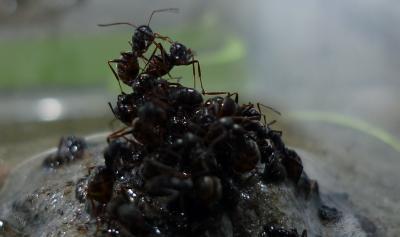Call it the buoyancy of the brood.
When facing a flood, ants build rafts and find other ways to minimize injury or death - they can basically use the brood to act as a life preserver - according to a new paper. The queen ant goes in the middle and is protected on all sides by the rafting ants.
Ants are social, Edward O. Wilson has written whole books on that, and when put in harm's way, social animals are often able to work together to enhance the survival and welfare of the group. Ants living on flood plains are known to link to together to create rafts during floods, but less is known about the composition, shape, and social structure of these rafts.
To better understand this process, scientists collected ants from a flood plain in Switzerland and brought them back to the lab so they could induce flooding in ant populations containing different combinations of worker ants, queens, and broods (containing developing larvae and pupae). During the 'flooding,' they observed where the workers, brood, and queens were positioned in the raft. The flooding also allowed them to observe the buoyancy and recovery ability of the worker ants and brood.

Ants building a raft. Credit: Jessica Purcell
The researchers found that the worker ants and brood were extremely resistant to submersion. The workers protected the most vulnerable and valuable nest mate, the queen, by placing her in the center of the raft, and the worker ants used the buoyancy of the brood at the base and recovery ability of workers to create a raft and minimize ant injury or death.
Both workers and brood exhibited high survival rates after they rafted, which suggests that occupying the base of the raft is not as deadly as scientists expected. Placing the brood at the base of the raft may also aid in keeping the nest together during the flood.
"We expected that individuals submerged on the base of the raft would face the highest cost, so we were astonished to see the ants systematically place the youngest colony members in that positions. Further experiments revealed that the brood are the most buoyant members of the society and that rafting does not decrease their survival; thus, this configuration benefits the group at minimal cost," says lead author Jessica Purcell from University of Lausanne.






Comments